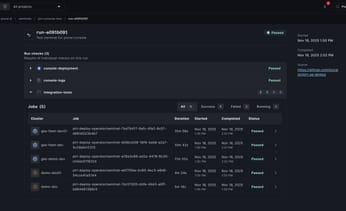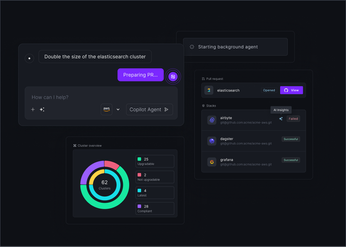
How Platform Engineering Enhances DevOps Workflows
Learn how platform engineering enhances DevOps workflows by streamlining processes, reducing cognitive load, and enabling developer self-service.
The promise of Kubernetes is immense, but so is its complexity. For many teams, managing container orchestration means wrestling with a steep learning curve, intricate YAML configurations, and ongoing security concerns. Platform engineering tackles this head-on by building an abstraction layer over the complexity, delivering standardized tools and automated “golden paths” for common tasks like deploying a new service or provisioning a database. These predefined workflows embed security and compliance guardrails by design, allowing developers to operate safely without becoming Kubernetes experts. The result is a structured, repeatable DevOps workflow that transforms Kubernetes from a potential operational bottleneck into a genuine accelerator for innovation.
Unified Cloud Orchestration for Kubernetes
Manage Kubernetes at scale through a single, enterprise-ready platform.
Key takeaways:
- Abstract complexity to increase developer velocity: Platform engineering builds a standardized layer over complex systems like Kubernetes, providing developers with self-service, automated workflows that let them ship code faster without needing to be infrastructure experts.
- Codify best practices into the platform: An effective platform embeds security, compliance, and operational standards directly into its tooling. This creates "golden paths" that guide teams to build and deploy applications consistently and securely by default.
- Treat your platform as an internal product: A successful platform engineering strategy requires treating developers as customers. This means defining success with clear metrics, establishing tight feedback loops, and continuously iterating to solve real-world developer friction.
What Is Platform Engineering?
Platform engineering applies product management principles to internal tooling, creating a “paved road” that abstracts away infrastructure complexity. It gives development teams a curated set of tools and automated workflows, enabling them to build, deploy, and manage applications faster and with more autonomy. This approach reduces the operational friction that often slows development in cloud-native environments—especially those built on Kubernetes. By delivering a stable, self-service foundation, platform engineering frees developers to focus on delivering business value instead of fighting infrastructure.
From DevOps to Platform Engineering
Platform engineering isn’t a replacement for DevOps—it’s a specialized, scalable implementation of its principles. As organizations grow, the cognitive load on developers increases, forcing them to juggle expertise in container orchestration and cloud networking. Platform engineering formalizes the toolchains and workflows that DevOps teams often assemble ad hoc, turning them into a structured, reusable foundation. It codifies best practices into self-service “golden paths” that help teams ship faster without sacrificing security or reliability.
Core Components and Key Benefits
At the heart of platform engineering is the Internal Developer Platform (IDP)—a curated layer of tools, services, and workflows that abstract infrastructure complexity. Developers use the IDP to self-serve common needs, from provisioning databases to deploying to Kubernetes. Key benefits include:
- Lower cognitive load: Developers can focus on coding, not infrastructure.
- Higher productivity: Automated workflows reduce manual tasks and errors.
- Faster onboarding: New engineers ramp up quickly in a standardized environment.
Platforms like Plural exemplify this approach, offering a single pane of glass to manage entire Kubernetes fleets while embedding security and compliance guardrails by design.
Platform Engineers vs. DevOps Teams
While they often collaborate, the focus differs. DevOps is a cultural and procedural framework aimed at breaking down silos and accelerating delivery across the entire software lifecycle. Platform engineering is a specialized discipline dedicated to building and maintaining the IDP. Platform engineers treat the platform as a product—gathering requirements, prioritizing features, and ensuring developer needs are met. A DevOps specialist might define a CI/CD process, while a platform engineer builds the automated pipeline that powers it.
Key Components of a Modern Engineering Platform
A modern engineering platform is not a single product but a composition of integrated tools and workflows designed to create a "paved road" for developers. This approach abstracts away the underlying infrastructure complexity, allowing development teams to build, ship, and run applications with greater speed and autonomy. The goal is to provide a reliable, secure, and efficient path from code to production. This platform is built on several key components that work together to streamline the entire software development lifecycle.
These foundational pillars include an Internal Developer Platform (IDP) that serves as the primary user interface, Infrastructure as Code (IaC) for automated and repeatable environment provisioning, and automated CI/CD pipelines that standardize testing and deployment. A self-service portal with a service catalog completes the picture, empowering developers to access the tools and resources they need on demand. When implemented correctly, these components reduce cognitive load on developers, enforce standards, and enable the organization to scale its DevOps practices effectively.
Internal Developer Platforms
An IDP serves as a centralized hub where developers access the tools, services, and automated workflows needed for their work. As Red Hat notes, IDPs function as a "one-stop shop" that simplifies onboarding and accelerates development. Instead of navigating a complex web of disparate systems, developers interact with a single, cohesive interface. This platform abstracts away the intricacies of Kubernetes and cloud services, along with CI/CD tooling. Plural provides this unified experience for Kubernetes management, offering a single pane of glass that integrates deployment pipelines, infrastructure management, and observability. This allows developers to manage applications without needing deep expertise in the underlying infrastructure.
Infrastructure as Code
Infrastructure as Code (IaC) is the practice of managing and provisioning infrastructure through code and automation rather than manual processes. By defining resources like virtual machines, networks, and load balancers in declarative configuration files, teams can create consistent and reproducible environments. This is critical for achieving the "scalable automation" that modern operations require. Plural Stacks embeds this principle directly into its platform with an API-driven framework for managing Terraform. This feature allows teams to handle complex cloud infrastructure dependencies as part of a unified, GitOps workflow, ensuring that infrastructure changes are versioned, reviewed, and applied with the same rigor as application code.
CI/CD Pipeline Automation
CI/CD pipelines automate the process of building, testing, and deploying code, forming the backbone of modern software delivery. Platform engineering enhances this by providing standardized, reusable pipeline templates. This prevents individual teams from building their own bespoke deployment mechanisms, ensuring consistency and security across the organization. Plural CD focuses on streamlining the continuous delivery (CD) aspect for Kubernetes environments. Plural CD uses a secure, agent-based GitOps model to automatically sync application configurations to target clusters. This decouples the deployment logic from the pipeline, allowing developers to push code to Git while the platform handles the complexities of safely rolling it out across a fleet of clusters.
Service Catalogs and Self-Service Portals
A service catalog provides developers with a curated menu of "ready-to-use services," tools, and application templates that they can provision on their own. This self-service capability is a core tenet of platform engineering, as it reduces dependencies on a central operations team and eliminates bottlenecks. By offering pre-approved components, the platform team can ensure that developers are using secure and compliant tools without slowing them down. Plural facilitates this through its self-service code generation capabilities and a catalog of open-source applications. Developers can use a simple UI wizard to generate the necessary manifests for a new service or deploy complex applications like Apache Airflow or Airbyte with a few clicks, empowering them to build faster.
How Platform Engineering Improves DevOps Workflows
Platform engineering refines DevOps principles by creating a paved road for development teams. Instead of each team building and managing its own toolchains, a centralized platform provides standardized, automated, and self-service capabilities. This approach addresses common DevOps bottlenecks, such as infrastructure provisioning delays, inconsistent environments, and the cognitive load placed on developers. By treating infrastructure as a product, platform engineering allows DevOps teams to scale their impact, enforce best practices, and enable developers to ship code faster and more reliably. The result is a more efficient software delivery lifecycle where operational complexity is abstracted away, letting teams focus on their core responsibilities.
A well-designed platform doesn't just offer tools; it offers a curated experience that guides developers toward best practices without restricting their ability to innovate. It codifies organizational knowledge about security , compliance , and operations into automated workflows. For organizations managing large Kubernetes fleets, this becomes essential. The platform handles the underlying complexity of cluster management, deployment pipelines, and observability, presenting a simplified interface to developers. This allows an organization to maintain velocity and agility even as its systems grow in scale and complexity, turning infrastructure from a constraint into an accelerator for business value.
Automate Infrastructure Management
Platform engineering establishes standard workflows and provides tools that automate infrastructure provisioning and management. By creating reusable templates and components, platform teams eliminate the manual, error-prone tasks that often slow down DevOps cycles. This automation is critical for managing complex environments like Kubernetes at scale. For example, Plural uses an API-driven approach to manage Infrastructure as Code (IaC), allowing teams to declaratively define and execute Terraform runs across an entire fleet. This ensures that infrastructure is provisioned consistently and repeatably, reducing the operational burden on individual teams and minimizing configuration drift.
Enable Developer Self-Service
A core goal of platform engineering is to empower developers with self-service capabilities. Internal Developer Platforms (IDPs) let developers access the resources they need—such as new testing environments or databases—without filing a ticket and waiting for an operations team. This autonomy significantly reduces friction and shortens development cycles. Plural facilitates this through its self-service code generation, which provides a simple UI wizard for generating the necessary manifests for new services or infrastructure. This allows developers to provision resources independently while adhering to the organization's predefined standards and guardrails.
Standardize Development Environments
Inconsistent environments are a frequent source of "it works on my machine" issues, leading to wasted time and deployment failures. Platform engineering solves this by providing standardized, "ready-to-use services" and environments. This ensures that development, testing, and production environments are as identical as possible, which simplifies debugging and improves deployment reliability. Plural enforces this standardization through its GitOps -based continuous deployment, which syncs Kubernetes manifests from a central repository to every cluster in the fleet. This creates a single source of truth for application and infrastructure configuration, ensuring consistency everywhere.
Integrate Security and Compliance
Platform engineering integrates security and compliance directly into the development workflow, shifting it from a final-stage gate to a continuous process. By embedding security controls, policies, and scans into the platform itself, teams can catch vulnerabilities and misconfigurations early. This "paved road" comes with built-in guardrails that ensure all deployments meet organizational standards. Plural’s architecture enhances security by using an agent-based model that avoids storing cluster credentials centrally. Furthermore, it simplifies the management of access controls by allowing teams to define and sync RBAC policies across the entire Kubernetes fleet, ensuring consistent and auditable permissions.
Address Common Integration Challenges
While DevOps principles aim to break down silos, many organizations find that integration remains a persistent challenge. Development, operations, and security teams often work with different toolchains, conflicting priorities, and inconsistent workflows, which creates friction and slows down the software delivery lifecycle. These bottlenecks undermine the core goal of shipping reliable software quickly and efficiently. Instead of fostering collaboration, the environment can breed frustration as teams struggle to align their processes and bridge knowledge gaps.
Platform engineering directly confronts these issues by creating a unified, standardized foundation for the entire engineering organization. It establishes a central platform that abstracts away the complexity of underlying infrastructure and provides a curated set of tools and automated workflows. This approach provides a practical structure to support the cultural ideals of DevOps. By codifying best practices and offering a shared, self-service layer, a well-designed platform turns collaboration from a constant effort into a default state. It provides the common ground needed to align teams, streamline toolchains, bridge skills gaps, and embed essential functions like security from the very beginning.
Aligning Teams and Overcoming Cultural Resistance
DevOps is as much about culture as it is about tools, but cultural change is difficult to sustain without a technical framework to support it. Platform engineering provides that framework. By creating a shared, self-service platform, it establishes common ground where development, operations, and security teams can collaborate effectively within a standardized environment. Instead of negotiating processes for every new project, teams work with pre-approved workflows, which turns collaboration into a default state rather than a constant effort. This structural approach helps overcome common DevOps challenges by creating a system that naturally fosters integration and reduces the "us vs. them" mentality that can arise between siloed teams.
Reducing Tool Sprawl and Cognitive Load
Modern development environments are often cluttered with a wide array of specialized tools, forcing developers to become experts in multiple complex systems. This tool sprawl increases cognitive load and distracts them from their primary job: writing code. Platform engineering cuts through this complexity by creating an Internal Developer Platform (IDP) that offers a curated, integrated set of tools and standardized workflows. These "golden paths" for common tasks simplify the developer experience. A unified platform like Plural acts as a single pane of glass for Kubernetes, consolidating dashboarding, GitOps deployments, and infrastructure management into one cohesive and intuitive interface.
Bridging the Engineering Skills Gap
Not every developer can be a Kubernetes expert, and for many organizations, the engineering skills gap is a major hurdle. According to a Red Hat report, 34% of organizations cite skills gaps as a significant challenge in their platform engineering initiatives. Platform engineering addresses this by abstracting away the complexity of the underlying infrastructure. It empowers developers to deploy and manage applications through self-service portals and automated workflows without needing deep specialized knowledge. With Plural, for example, developers can use simple UI wizards for self-service code generation, creating the necessary manifests to deploy an application without writing complex Kubernetes YAML by hand. This lowers the barrier to entry and enables the entire engineering organization to move faster.
Integrating Security Without Slowing Down
Integrating security into the development lifecycle is critical, but it often becomes a bottleneck that slows down delivery. Platform engineering solves this by embedding security controls and policies directly into the platform’s automated workflows. This approach makes security a built-in, non-negotiable part of the process rather than a final gate before production. It helps increase the speed and quality of software development through scalable automation and improved security. Using Plural, teams can define fleet-wide RBAC policies and use Global Services to automatically sync them across all clusters. This ensures security standards are consistently enforced without requiring manual intervention for every deployment.
Build an Effective Platform Engineering Strategy
Transitioning to a platform engineering model requires more than just adopting new tools; it demands a deliberate strategy that aligns technology with organizational goals. An effective strategy serves as a blueprint for building an internal platform that not only streamlines DevOps workflows but also delivers tangible value to developers and the business. This involves defining success, standardizing processes, fostering open communication, and creating tight feedback loops. By focusing on these core pillars, you can build a platform that accelerates development cycles, improves reliability, and empowers your engineering teams to innovate faster.
Set Clear Goals and Metrics
To build a successful platform, you must first define what success looks like. Vague objectives lead to unfocused efforts and make it impossible to demonstrate value. Success should be measured through a combination of quantitative metrics and qualitative feedback from your internal users—the developers. Key metrics often include the four DORA metrics: deployment frequency, lead time for changes, mean time to recovery (MTTR), and change failure rate. You can also track developer onboarding time and the volume of internal support tickets. This data provides a clear picture of your platform's impact on efficiency and stability. A unified dashboard, like the one in Plural, offers the single-pane-of-glass visibility needed to monitor these metrics across your entire Kubernetes fleet.
Implement Standardized Processes
Platform engineering creates standard ways of working and provides tools that developers can use themselves, which streamlines workflows and enhances productivity. Standardization is about creating "golden paths"—well-defined, supported workflows for common tasks like provisioning infrastructure, setting up a new service, or deploying an application. This approach reduces cognitive load on developers, as they no longer need to be experts in every underlying technology. With Plural Stacks, you can codify these golden paths using Terraform and expose them through a simple, API-driven interface. This ensures every team follows best practices for security, compliance, and configuration without sacrificing speed.
Establish Clear Communication Channels
A platform is a product for your internal developers, and like any good product, it requires strong communication between the builders and the users. Clear communication channels are essential for fostering collaboration and breaking down the silos that can form between platform and application teams. Establish dedicated channels for announcements, support, and feedback, such as a Slack channel or regular office hours. Documentation should be treated as a first-class citizen, providing clear instructions and examples for using the platform. This collaborative approach ensures the platform team builds what developers actually need, rather than what they think they need, preventing the platform from becoming another layer of friction.
Create Effective Feedback Loops
A platform is never truly "done." It must evolve based on the changing needs of your developers. Creating effective feedback loops is essential for this continuous improvement. Regularly solicit input through surveys, one-on-one interviews, and direct observation to identify friction points in the developer experience. When you receive feedback, act on it. For example, if multiple teams struggle with a complex deployment process, use that insight to build a new self-service workflow that automates the task. Addressing friction points through these mechanisms is essential for improving the developer experience and ensuring your platform remains a valuable asset rather than a legacy burden.
Platform Engineering Tools and Best Practices
Building an effective internal platform requires a curated set of tools that work together to automate workflows, manage complexity, and provide self-service capabilities. The right technology stack not only supports the platform team but also empowers developers by giving them paved roads for building and deploying applications. Here are the essential tool categories and best practices for each.
Infrastructure Automation Solutions
Platform engineering relies on scalable automation to increase development speed and quality. Infrastructure as Code (IaC) is a foundational practice, allowing teams to define and manage infrastructure using version-controlled configuration files. This approach ensures consistency, repeatability, and traceability across all environments. By codifying infrastructure, platform teams can eliminate manual configuration errors and create standardized building blocks for developers. Plural extends this with an API-driven workflow for managing Terraform. Our Plural Stacks feature treats IaC as a first-class citizen, automating plan and apply cycles on code commits and enabling platform teams to manage complex infrastructure dependencies at scale.
Kubernetes Management Platforms
As Kubernetes becomes the standard for container orchestration, managing its complexity is a primary challenge. A dedicated management platform is essential for enhancing developer efficiency and bridging the gap between development and operations. These platforms provide a stable, secure, and abstracted layer over raw Kubernetes infrastructure. Plural acts as a single pane of glass for your entire Kubernetes fleet, using a secure, agent-based architecture to manage clusters across any cloud or on-prem environment. This unified approach simplifies cluster lifecycle management, automates deployments through GitOps, and provides developers with a consistent interface, regardless of the underlying infrastructure.
Monitoring and Observability Systems
A platform is only as good as its reliability. Effective monitoring and observability systems are critical for achieving goals like zero-downtime deployments and maintaining performance. These systems go beyond simple metric collection, providing deep insights into application behavior, dependencies, and failure modes. This visibility allows platform teams to proactively identify issues and quickly troubleshoot problems. Plural integrates an embedded Kubernetes dashboard directly into its console, providing secure, SSO-integrated access to workload telemetry. Because it uses the same egress-only communication channel as our deployment agent, you gain full observability into private and on-prem clusters without complex network configurations or VPNs.
Security and Compliance Tools
Security is not a separate step but an integrated component of a modern engineering platform. Research shows that improved security is one of the most critical metrics for platform engineering success. This involves embedding security controls, policies, and scanning directly into the development lifecycle. By providing developers with secure-by-default templates and automated compliance checks, platform teams can reduce risk without slowing down delivery. Plural’s architecture enhances security by design. Our agent-based model eliminates the need for a central management plane to hold cluster credentials. Furthermore, our dashboard uses Kubernetes impersonation, allowing you to manage access with fine-grained RBAC policies tied directly to your organization’s identity provider.
What's Next for Platform Engineering?
Platform engineering is not a static discipline; it continuously adapts to new technologies and organizational needs. As teams look to the future, several key trends are shaping how platforms are built, managed, and utilized. The focus remains on abstracting complexity and improving the developer experience, but the methods for achieving this are becoming more sophisticated. Understanding these trends is critical for any organization aiming to maintain a competitive edge in software delivery. The goal is to create a paved road that allows development teams to ship applications faster and more reliably, while the platform team handles the underlying complexity of infrastructure, security, and compliance.
The Role of AI and Machine Learning
As organizations work to maximize their platform engineering initiatives, many are incorporating artificial intelligence to streamline operations. AI is not just a buzzword in this context; it offers practical solutions to complex problems. For instance, AI-powered tools can perform automatic root cause analysis by correlating signals across disparate systems like Terraform logs, Kubernetes events, and GitOps manifests. This capability drastically reduces the time engineers spend troubleshooting. At Plural, our AI Insight Engine pinpoints the source of an issue and suggests actionable code changes, allowing teams to resolve problems faster. This moves teams from reactive firefighting to proactive, AI-assisted problem-solving.
The Continued Evolution of Cloud-Native
Platform engineering is deeply intertwined with the evolution of cloud-native technologies. As more organizations adopt distributed systems, the need for a standardized, scalable way to manage them becomes paramount. Platforms built on cloud-native principles provide the necessary guardrails and abstractions for developers to work efficiently without needing deep expertise in Kubernetes or service mesh configurations. This approach allows teams to harness the power of DevOps to improve software quality and accelerate delivery. The future will see platforms offering even tighter integrations with underlying cloud-native services, making it simpler to deploy, observe, and secure complex applications across multi-cloud and edge environments.
What to Watch: Emerging Tech and Practices
Looking ahead, platform engineering will focus on solving persistent operational challenges. Even mature organizations face issues with workflow integration, security risks, and a persistent engineering skills gap. The next wave of platform tools will address these problems head-on by providing more cohesive, secure-by-default environments. This means building platforms that not only automate infrastructure but also embed policy and compliance checks directly into the developer workflow. The goal is to reduce cognitive load by presenting a curated set of tools and golden paths, enabling developers to self-serve with confidence while platform teams maintain control and visibility over the entire stack.
Related Articles
Unified Cloud Orchestration for Kubernetes
Manage Kubernetes at scale through a single, enterprise-ready platform.
Frequently Asked Questions
Isn't platform engineering just a new name for DevOps? Not quite. Think of it this way: DevOps is the cultural philosophy of breaking down silos between development and operations. Platform engineering is a specific discipline that puts that philosophy into practice at scale. It does this by building and maintaining an Internal Developer Platform (IDP) that is treated like a product for your internal developers. While a DevOps team might create a CI/CD pipeline for a single project, a platform team builds the standardized, reusable pipeline components that any developer can use to create their own pipeline through self-service.
Is platform engineering only for large enterprises? While platform engineering is essential for managing complexity at a large scale, the core principles are valuable for teams of any size. The goal is to reduce cognitive load and create standardized, repeatable workflows. Even in a small team, establishing a "paved road" for common tasks like deployments or environment creation prevents technical debt and ensures consistency as you grow. Starting with a platform mindset early on builds a solid foundation, making it easier to scale your operations later without having to untangle years of ad-hoc processes.
How does a platform engineering approach specifically help with managing Kubernetes? Kubernetes is incredibly powerful, but its complexity can be a major hurdle for development teams. A platform engineering approach abstracts away that complexity. Instead of requiring every developer to master kubectl commands and YAML manifests, the platform provides a simplified, self-service interface for deploying and managing applications. For example, a platform like Plural provides a single pane of glass that handles GitOps-based deployments, infrastructure provisioning, and observability, allowing developers to work efficiently without needing to become Kubernetes experts.
What's the first practical step my team can take to start building an internal platform? The first step isn't to choose a tool, but to talk to your users—the developers. Treat your platform as a product and identify your customers' biggest pain points. Is it spinning up a new testing environment? Is it navigating a complex deployment process? Find the single most significant point of friction in their workflow and build a "golden path" to solve that one problem. Start small, deliver value quickly, and iterate based on feedback.
What is the biggest mistake teams make when adopting platform engineering? The most common mistake is focusing on building the platform without focusing on the developer experience. Teams can get caught up in creating a technically perfect system with rigid guardrails, only to find that developers see it as another obstacle. A platform that doesn't solve real problems or is too inflexible will be ignored. The key is to treat the platform as an internal product that must constantly evolve based on user feedback to remain valuable.
Newsletter
Join the newsletter to receive the latest updates in your inbox.









